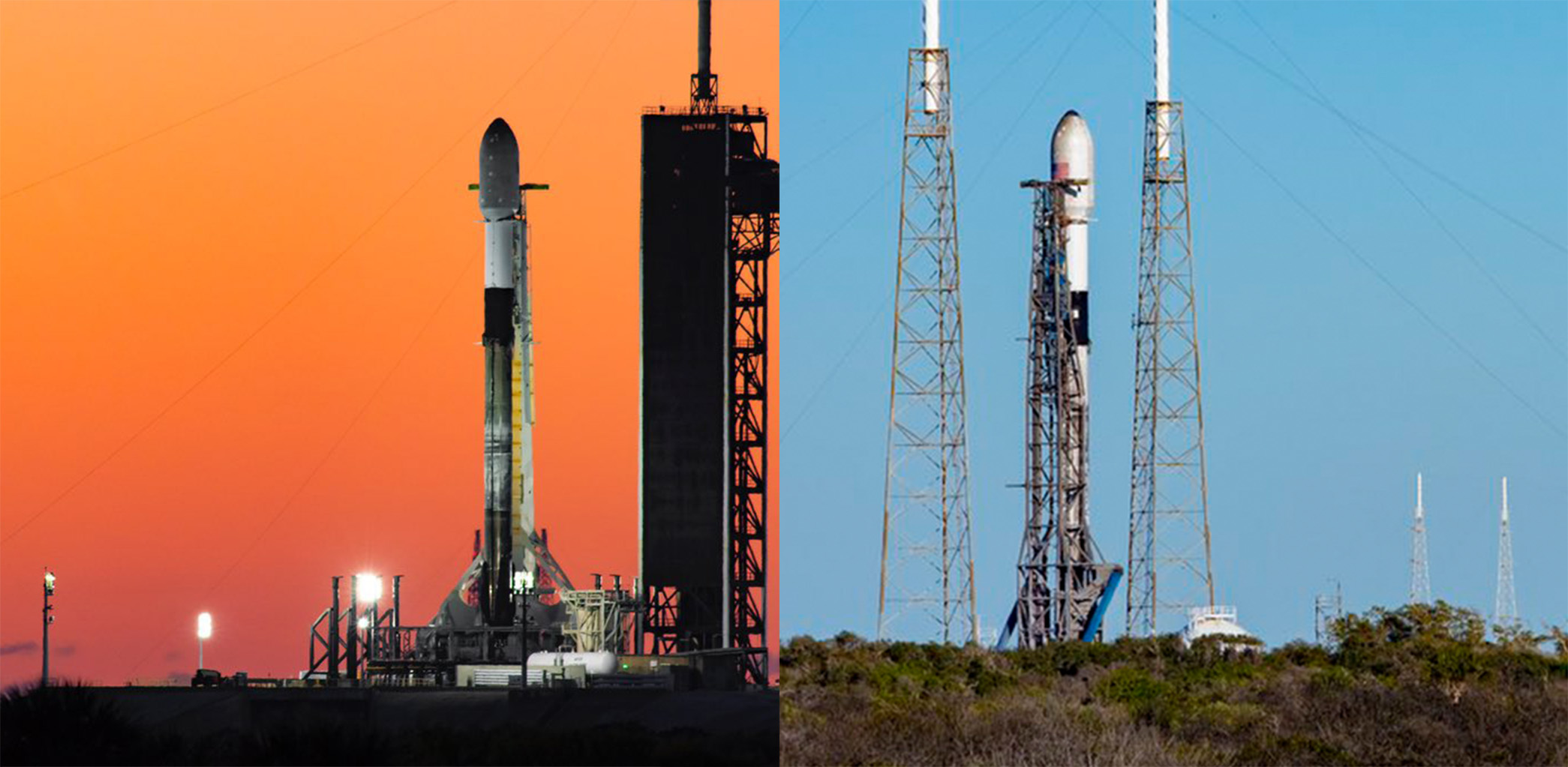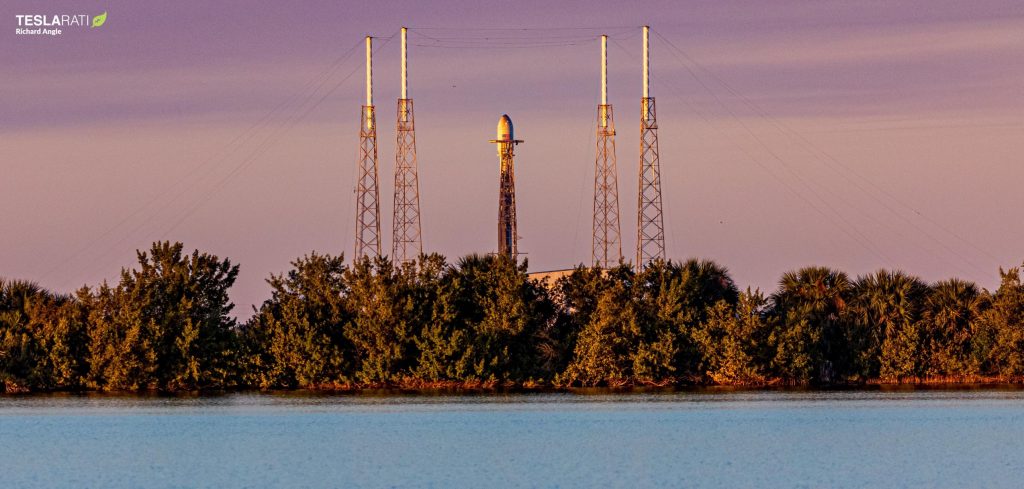

News
SpaceX to launch trio of Falcon 9 rockets this week
A wayward cruise ship has singlehandedly delayed two SpaceX launches and forced schedule changes that could see three Falcon 9 rockets lift off just a handful of days apart.
Originally scheduled to launch six days apart on January 27th, January 28th, and February 2nd, a string of mostly weather-related delays has pushed SpaceX’s launch of the Italian CSG-2 radar satellite – the first of the series – to January 28th, 29th, 30th, and now the 31st. Weather for the fifth launch attempt looks optimal, so barring another stroke of terrible maritime luck, CSG-2 will once again attempt to lift off at 6:11 pm EST (23:11 UTC) on Monday, January 31st.
If all goes to plan, CSG-2 will be SpaceX’s fourth launch of the month and year, leaving the company more or less on track to achieve a target of 52 launches – an average of one launch per week – in 2022. It will also be the seventh time SpaceX has launched four or more times in less than four weeks – the first instance of which occurred less than a year and a half ago.
According to SpaceX’s CSG-2 webcast host (also an engineer at the company), January 31st will be SpaceX’s last consecutive CSG-2 launch attempt if another issue arises. The company will apparently turn its full attention to the National Reconnaissance Office’s (NRO) NROL-87 spy satellite no less than a day and a half before its scheduled 12:18 pm PST (20:18 UTC), Wednesday, February 2nd liftoff. If true, that means that a lone cruise ship will have ultimately delayed a commercial Falcon 9 launch by at least 24 hours and a separate Starlink Falcon 9 launch by at least three days.

Prior to that ship’s unwelcome appearance, Starlink 4-7 was scheduled to launch no earlier than (NET) 2pm EST (19:00 UTC) on Monday, January 31st. Now, unless SpaceX decides that it can afford to support three different Falcon 9 launch attempts – spread out across all three of its orbital launch pads – as few as ~41 hours apart, Starlink 4-7 will probably have to wait until February 3rd at the earliest. Obviously, three launches in ~65 hours would still be an extremely impressive achievement for SpaceX and the Falcon family. It would also be a new record, narrowly edging out the old record of three launches in ~69 hours set in December 2021. Nevertheless, there is some evidence that Starlink 4-7 could launch as early as 1:56 pm EST (18:56 UTC), February 1st, so there’s still a chance that SpaceX will launch three Falcon 9 rockets in less than 48 hours.
It’s clear that SpaceX is making significant progress in increasing its launch cadence capabilities and sustaining those increases. Nonetheless, the more SpaceX pushes that envelope, the more and more common similar knock-on delays and rare launch abort scenarios will become – just an inevitable consequence of any attempt to make orbital launches truly common and routine.
Tune in below around 5:55 pm EST (22:55 UTC), January 31st to watch Falcon 9’s fifth CSG-2 launch attempt live.

News
Elon Musk’s Grok AI to be used in U.S. War Department’s bespoke AI platform
The partnership aims to provide advanced capabilities to 3 million military and civilian personnel.

The U.S. Department of War announced Monday an agreement with Elon Musk’s xAI to embed the company’s frontier artificial intelligence systems, powered by the Grok family of models, into the department’s bespoke AI platform GenAI.mil.
The partnership aims to provide advanced capabilities to 3 million military and civilian personnel, with initial deployment targeted for early 2026 at Impact Level 5 (IL5) for secure handling of Controlled Unclassified Information.
xAI Integration
As noted by the War Department’s press release, GenAI.mil, its bespoke AI platform, will gain xAI for the Government’s suite of tools, which enable real-time global insights from the X platform for “decisive information advantage.” The rollout builds on xAI’s July launch of products for U.S. government customers, including federal, state, local, and national security use cases.
“Targeted for initial deployment in early 2026, this integration will allow all military and civilian personnel to use xAI’s capabilities at Impact Level 5 (IL5), enabling the secure handling of Controlled Unclassified Information (CUI) in daily workflows. Users will also gain access to real‑time global insights from the X platform, providing War Department personnel with a decisive information advantage,” the Department of War wrote in a press release.
Strategic advantages
The deal marks another step in the Department of War’s efforts to use cutting-edge AI in its operations. xAI, for its part, highlighted that its tools can support administrative tasks at the federal, state and local levels, as well as “critical mission use cases” at the front line of military operations.
“The War Department will continue scaling an AI ecosystem built for speed, security, and decision superiority. Newly IL5-certified capabilities will empower every aspect of the Department’s workforce, turning AI into a daily operational asset. This announcement marks another milestone in America’s AI revolution, and the War Department is driving that momentum forward,” the War Department noted.
News
Tesla FSD (Supervised) v14.2.2 starts rolling out
The update focuses on smoother real-world performance, better obstacle awareness, and precise end-of-trip routing, among other improvements.

Tesla has started rolling out Full Self-Driving (Supervised) v14.2.2, bringing further refinements to its most advanced driver-assist system. The new FSD update focuses on smoother real-world performance, better obstacle awareness, and precise end-of-trip routing, among other improvements.
Key FSD v14.2.2 improvements
As noted by Not a Tesla App, FSD v14.2.2 upgrades the vision encoder neural network with higher resolution features, enhancing detection of emergency vehicles, road obstacles, and human gestures. New Arrival Options let users select preferred drop-off styles, such as Parking Lot, Street, Driveway, Parking Garage, or Curbside, with the navigation pin automatically adjusting to the user’s ideal spot for precision.
Other additions include pulling over for emergency vehicles, real-time vision-based detours for blocked roads, improved gate and debris handling, and extreme Speed Profiles for customized driving styles. Reliability gains cover fault recovery, residue alerts on the windshield, and automatic narrow-field camera washing for new 2026 Model Y units.
FSD v14.2.2 also boosts unprotected turns, lane changes, cut-ins, and school bus scenarios, among other things. Tesla also noted that users’ FSD statistics will be saved under Controls > Autopilot, which should help drivers easily view how much they are using FSD in their daily drives.
Key FSD v14.2.2 release notes
Full Self-Driving (Supervised) v14.2.2 includes:
- Upgraded the neural network vision encoder, leveraging higher resolution features to further improve scenarios like handling emergency vehicles, obstacles on the road, and human gestures.
- Added Arrival Options for you to select where FSD should park: in a Parking Lot, on the Street, in a Driveway, in a Parking Garage, or at the Curbside.
- Added handling to pull over or yield for emergency vehicles (e.g. police cars, fire trucks, ambulances).
- Added navigation and routing into the vision-based neural network for real-time handling of blocked roads and detours.
- Added additional Speed Profile to further customize driving style preference.
- Improved handling for static and dynamic gates.
- Improved offsetting for road debris (e.g. tires, tree branches, boxes).
- Improve handling of several scenarios, including unprotected turns, lane changes, vehicle cut-ins, and school buses.
- Improved FSD’s ability to manage system faults and recover smoothly from degraded operation for enhanced reliability.
- Added alerting for residue build-up on interior windshield that may impact front camera visibility. If affected, visit Service for cleaning!
- Added automatic narrow field washing to provide rapid and efficient front camera self-cleaning, and optimize aerodynamics wash at higher vehicle speed.
- Camera visibility can lead to increased attention monitoring sensitivity.
Upcoming Improvements:
- Overall smoothness and sentience.
- Parking spot selection and parking quality.
News
Tesla is not sparing any expense in ensuring the Cybercab is safe
Images shared by the longtime watcher showed 16 Cybercab prototypes parked near Giga Texas’ dedicated crash test facility.

The Tesla Cybercab could very well be the safest taxi on the road when it is released and deployed for public use. This was, at least, hinted at by the intensive safety tests that Tesla seems to be putting the autonomous two-seater through at its Giga Texas crash test facility.
Intensive crash tests
As per recent images from longtime Giga Texas watcher and drone operator Joe Tegtmeyer, Tesla seems to be very busy crash testing Cybercab units. Images shared by the longtime watcher showed 16 Cybercab prototypes parked near Giga Texas’ dedicated crash test facility just before the holidays.
Tegtmeyer’s aerial photos showed the prototypes clustered outside the factory’s testing building. Some uncovered Cybercabs showed notable damage and one even had its airbags engaged. With Cybercab production expected to start in about 130 days, it appears that Tesla is very busy ensuring that its autonomous two-seater ends up becoming the safest taxi on public roads.
Prioritizing safety
With no human driver controls, the Cybercab demands exceptional active and passive safety systems to protect occupants in any scenario. Considering Tesla’s reputation, it is then understandable that the company seems to be sparing no expense in ensuring that the Cybercab is as safe as possible.
Tesla’s focus on safety was recently highlighted when the Cybertruck achieved a Top Safety Pick+ rating from the Insurance Institute for Highway Safety (IIHS). This was a notable victory for the Cybertruck as critics have long claimed that the vehicle will be one of, if not the, most unsafe truck on the road due to its appearance. The vehicle’s Top Safety Pick+ rating, if any, simply proved that Tesla never neglects to make its cars as safe as possible, and that definitely includes the Cybercab.








